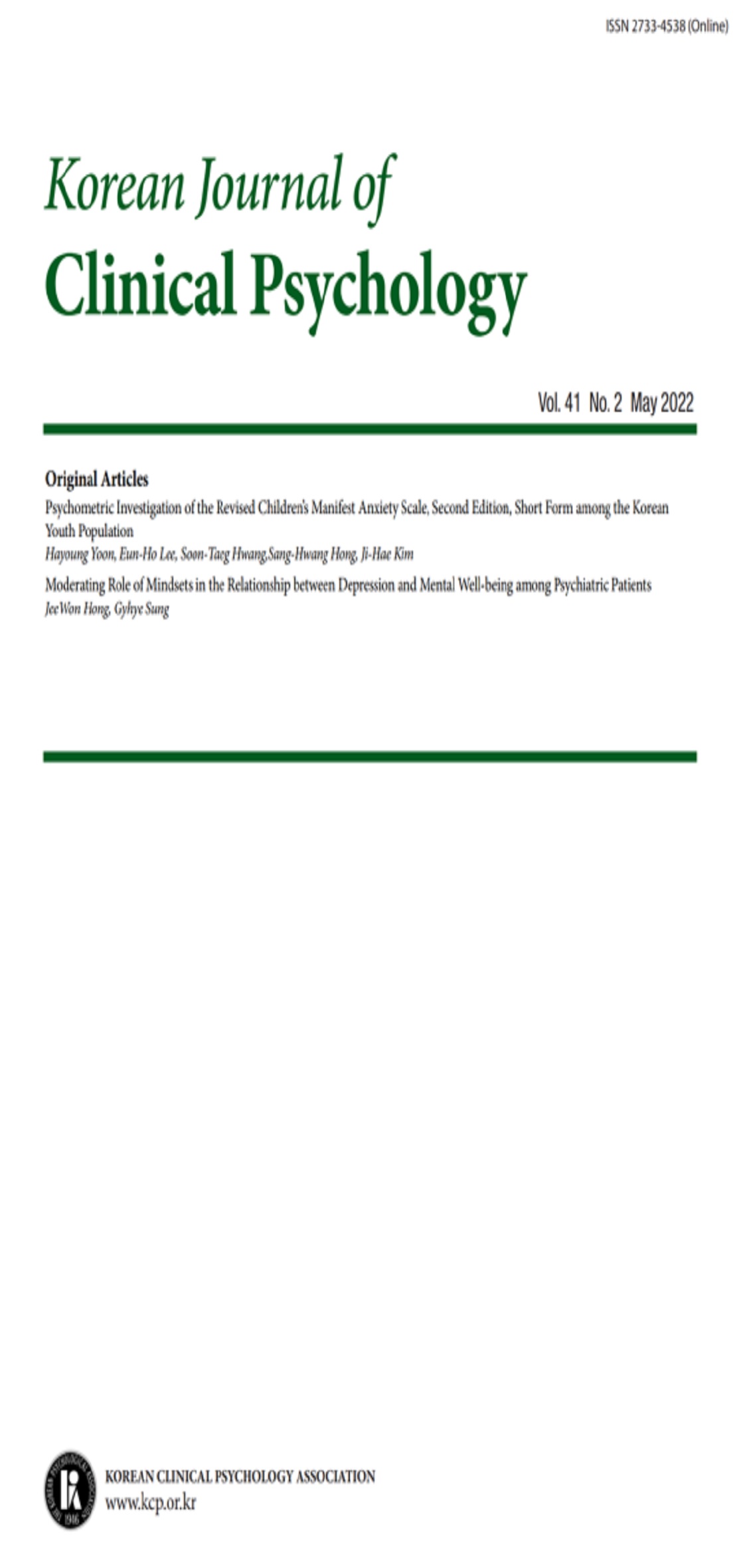open access
메뉴
open access
메뉴 E-ISSN : 2733-4538
E-ISSN : 2733-4538
본 연구에서는 임상경험과 연구를 통해 축적되어 온 MMPI 해석지침을 MMPI-2에서도 그대로 사용할 수 있는지 알아보기 위해 두 검사 프로파일의 일치성을 비교하였다. 대학생 집단에게 순서효과를 통제하면서 1주일 간격으로 MMPI와 MMPI-2를 실시하였다. 두 검사의 13개 기본척도에 대한 상관집단 t-test 결과 타당도 척도 F와 임상 척도 2, 3을 제외한 10 개의 척도에서 유의미한 평균 차이가 나타났다. 상하 양 극단 프로파일의 두 검사간 비교에서 MMPI에 비해 MMPI-2에서 프로파일 앞쪽의 신경증 척도들은 다소 낮게, 뒤쪽의 정신증 척도들은 다소 높게 나타나는 양상을 보였다. 두 검사 T 점수의 상관을 산출한 결과 모든 척도쌍에서 대체로 높은 정적 상관이 있었다. 코드타잎 일치율을 분석한 결과, 제 1 상승척도의 일치율은 36.5%, 2 코드타잎의 일치율은 19.2%로 낮게 나왔으며, Graham 등(1991)이 제안한 ‘잘 정의된(well-defined) 코드타잎’을 적용한 경우 일치율은 각각 52.8%, 100%였다. 타당도 척도 중 하나 이상의 척도에서 T 70 이상이 있는 경우와 없는 경우에 두 검사간 임상척도의 상승척도 일치도에 차이가 있는지 χ2 검증을 통해 확인해본 결과 두 검사의 타당도 척도 중 T 70 이상이 존재하지 않는 경우에 두 검사간 상승척도 일치 사례의 빈도가 의미 있게 높았다. 이상의 결과를 MMPI-2 해석의 측면에서 선행연구들과 함께 논의하였다.
The aim of this study was to examine the consistency in the scores and profile of clinical subscales of the MMPI and MMPI-2. College students(N=156) completed the MMPI and MMPI-2 in a one week interval with counterbalanced order. Results of the t-tests showed that the Hs, D, Hy, and Pd of the MMPI-2 profile were lower and the MF, Pa, Pt, Sc, Ma and Si of the MMPI-2 profile were higher than those of the MMPI profile. Correlations between corresponding clinical scales of the MMPI and MMPI-2 were .36(MF)~.78(Si). Percentages of one-point and two-point code type congruence between the MMPI and MMPI-2 were 36.5% and 19.2%. But applied “well-defined”(Graham et al., 1991) code type, the percentages were increased to 52.8% and 100% each other. Implications of these results were discussed with the results of previous studies.
영환, 김재환, 김중술, 노명래, 신동균, 염태호, 오상우 (1989). 다면적 인성검사 실시 요강. 한국가이던스.
김중술 (1988). 다면적 인성검사: MMPI의 임상적 해석. 서울대학교출판부.
김중술, 한경희, 임지영, 이정흠, 민병배, 문경주 (2005). 다면적 인성검사 Ⅱ 매뉴얼. (주)마음사랑.
오상우, 조현섭 (1994). 신판 MMPI 검사-재검사 신뢰도. 한국심리학회지: 임상, 13, 54 -64.
한경희, 임지영, 민병배, 이정흠, 문경주, 김중술 (2006). 한국판 MMPI-2의 개발 연구. 한국심리학회지: 임상, 25, 533-564.
Chojnacki, J. T. & Walsh, W. B. (1992). The consistency of scores and configural patterns between the MMPI and MMPI-2. Journal of Personality Assessment, 59, 276-289.
Dahlstrom, W. G. (1992). Comparability of two-point hight-point code patterns from original MMPI norms to MMPI-2 norms for the restandardization sample. Journal of Personality Assessment, 59, 153-164.
Edwards, D. W., Morrison, T. L., & Weissman, H. N. (1993). The MMPI and MMPI-2 in an outpatient sample: Comparisons of code types, validity scales, and clinical scales. Journal of Personality Assessment, 61, 1-18.
Graham, J. R. (2007). MMPI-2 성격 및 정신병리 평가. ❲MMPI-2: Assessing Personality and Psychology❳. (이훈진, 문혜신, 박현진, 유성진, 김지영 역). 시그마프레스. (원전 1999년 출판).
Graham, J. R., Timbrook, R. E., & Ben-Porath, Y. S. (1991). Code-type congruence between MMPI and MMPI-2: Separating fact from artifact. Journal of Personality Assessment, 57, 205-215.
Humphrey, D. H. & Dahlstrom, W. G. (1995). The impact of changing from the MMPI to the MMPI-2 on profile configurations. Journal of Personality Assessment, 64, 428-439.
Tellegen, A. & Ben-Porath, Y. S. (1993). Code-type comparability of the MMPI and MMPI-2: Analysis of recent findings and criticisms. Journal of Personality Assessment, 61, 489-500.
